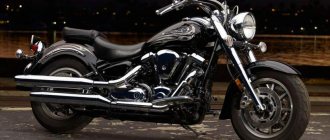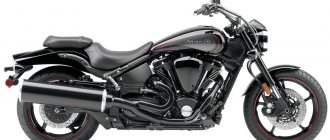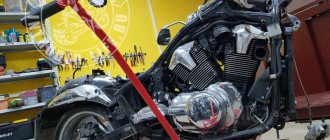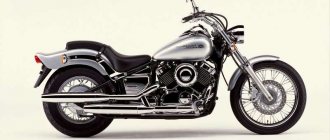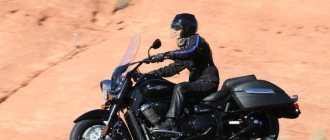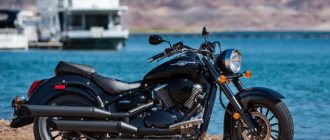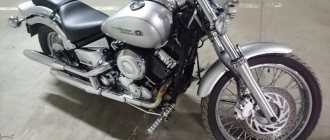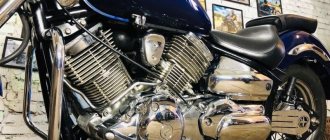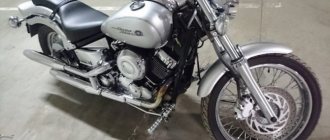Yamaha XV1700 Road Star Warrior (2002–2010, RUR 330,000–750,000)
The reason for the popularity of the Yamaha XV 1700 Road Star Warrior is its non-format design. An interesting motorcycle, no matter how you look at it. A kind of wolf in sheep's clothing. Under the guise of a heavy, sedate iron, there are technologies and solutions that are not typical for the class.
Engine
The low-air, dry-sump V-twin with electronic fuel injection, forged pistons, four valves and two spark plugs per cylinder is essentially a carryover from the XV1600 Wild Star. The power unit is extremely reliable. It is only important to strictly follow the instructions and schedule when servicing it.
Transmission
The five-speed Variora gearbox is not particularly smooth. It is important to treat it with care. With intentional long-term operation with sportbike-style short clutch releases and lightning-fast shifts, problems will not be long in coming. It is common for owners to complain about the lack of a sixth gear. The engine can still do something, but the gear ratios do not allow it to open up completely. The drive to the rear wheel is made by a maintenance-free timing belt. It is important to change it strictly according to the regulations and periodically inspect it for damage from stones and sand.
Frame and body kit
The frame of the Varior is the envy of many. Because it is not made of steel, as it might seem at first glance, but of aluminum. Hence the handling is very decent by the standards of the class and the dry weight is relatively small.
Brakes
The brake system mechanisms are borrowed from two different versions of the YZF - R 1. It all depends on the year of manufacture and the market. A heavy motorcycle is quite tough for them. It is important not to overdo it, since the motorcycle was not equipped with an anti-lock braking system.
Pendants
The chassis also shows the roots of Yamaha sportbikes. The front shifter copes well with its duties. The same cannot be said about the monoshock absorber. The combination of the rear pendulum and shock absorber suffers from insufficient energy consumption, which is why the motorcycle jumps on uneven surfaces.
Comfort
Frankly speaking, “Varior” is not the king of long-range fighters! More like a street dude flexing his muscles. The driver sits almost as if on a flying projectile. With legs, arms and head directed forward. The position encourages you to drive aggressively, but also exhausts you very quickly. The passenger has a spartan seat and is likely to get burned by the engine or massive exhaust parts.
Modifications
In 2006, the model was updated cosmetically. The Yamaha XV1700 series was produced until 2010, after which it was discontinued. The new motorcycles then stood in showrooms for another couple of years. At the end of production in 2010, a limited edition in black and yellow coloring was released.
Suzuki M 109 R Boulevard (2006 – present, 400,000–850,000 rub.)
Suzuki engineers are used to going beyond what is reasonable. How else can one explain the appearance of such a steroid-fed monster as the Suzuki Boulevard M 109 R (aka Boulevard M 109 R, M 1800, VZR 1800 and Intruder 1800). Regarding materiel, we have a very thick mix of a sportbike and a cruiser.
Engine
The "M" in the title stands for Muscle. “Muscularity” is primarily dictated by the power unit. Seriously sized (piston diameter 112 mm!) two-cylinder V-shape with a semi-dry sump, liquid cooling, fuel injection, two camshafts and four valves for each cylinder is stuffed in a sportbike style. Inside, there are forged aluminum pistons, chromium nitride coated oil rings, a reinforced crankshaft and chrome-moly connecting rods. Thanks to six silent blocks between the frame and the engine, there are not many unpleasant vibrations. The Boulevard engine loves very attentive maintenance, mainly due to the fact that it eats up oil with a decent appetite at high speeds. This behavior is not a malfunction, but a feature that should be taken into account. If you frequently drive at full throttle, the engine oil level should be checked before each trip. The semi-dry sump lubrication system does not like oil overfilling above the level. The excess is immediately squeezed out into the air filter.
Transmission
Due to careless use, the clutch often fails prematurely. It is difficult for him to resist a large powerful engine. On motorcycles produced before 2008, problems with the five-speed gearbox may occur. Torque is transmitted to the rear wheel by a driveshaft. It is almost impossible to “roll” it ahead of time. Plays and crunches can only appear from negligent maintenance.
Frame and body kit
Suzuki engineers deliberately did not switch to aluminum frames. The gain would be insignificant. For the M 109 R, the rigid steel structure proved justified. We limited ourselves to only an aluminum pendulum. The body kit, unfortunately, is not very durable. There are a lot of plastic parts and almost all of them are quite thin. Even a small accident can cause serious losses in terms of aesthetics. The blind plug at the rear does not contain the passenger seat underneath!
Brakes
The radial four-piston front calipers are not efficient enough for the heavy weight of the Boulevard M 109 R. Often you have to save yourself with the rear brake, which is not very informative.
Pendants
“Boulevard” is a big guy, and he needs appropriate pendants. The motorcycle rests on the asphalt with impressive size rubber “slippers” (130/70–18 and 240/40–18) through an inverted Kayaba fork with feathers as much as 46 mm. At the rear is a Link-type swingarm with single Kayaba shock absorbers. Brutal, not exactly very tough, but functional and definitely outside the genre.
Comfort
Comfort in this case is a constant value. The wide seat and the driver's footrests pulled forward create a completely relaxed driving position. You can and should go far! The passenger will also be comfortable. Adequate speed limit for the Suzuki Boulevard M 109 R is 120-160 km/h with occasional fleeting accelerations.
Modifications
In 2007 and 2008, the motorcycle received a slight cosmetic makeover. In 2008, in addition to the base model, a purely image special version, Boulevard M109R Limited Edition, was released (stripes across the entire motorcycle, transparent lighting fixtures, etc.). Autumn 2013 Suzuki has announced the completely chrome-free M109R BOSS (Blacked-Out Special Suzuki). From 2009 to 2011, the Suzuki Boulevard M 109 R 2 was produced - a special version that differs from the base M 109 R in lower dry weight, headlight, body kit parts and ergonomics.
First ride: 2006 Suzuki Boulevard M109R
You'll know it was the right decision as soon as you open the throttle on the M109R. After all, the GSX-R borrows the Suzuki dual throttle valve injection system. At almost any rpm, the bike simply pushes you back in the saddle, delivering a perfectly linear power distribution. This behavior of the motorcycle is well known to fans of sportbikes, as one of the recently acquired encouraging advantages of the GSX-R1000. Don't worry about the M109R's grotesque acceleration and just start racing with the GSX-R. This is the only thing you can do with 127 declared horsepower (at 6200 rpm) with a declared dry weight of 314 kilograms. Regardless, the M109R we drove in Austin, Texas, was certainly capable of meeting Suzuki's goals of making the most powerful V-twin cruiser yet. The all-new, V-twin (54-degree), two-cylinder, eight-valve, liquid-cooled, DOHC engine certainly has one of the essential ingredients for producing monstrous power - namely, displacement: 1783 cc. cm to be exact (or 109 cubic inches). To this can be added devices carried over from the GSX-R, such as forged aluminum pistons with a chrome-nitride coating and new oil control rings, a reinforced crankshaft and chrome-molybdenum connecting rods.This description, however, does not do justice to Suzuki's efforts in designing the M109R engine. The nearly 2-liter V-twin engine uses stepped crankpins for better balance, a counterweight and six mounts to support the steel frame; No production bike in recent memory has used all three technologies simultaneously to dampen vibration. In fact, vibration is a whole family, and anything that resembles it should be killed by the M109R's three-pronged approach.
Suzuki created a very rich exhaust note on the M109R with the help of specialists from Seikei University in Tokyo. Starting with about 100 exhaust sounds, about 250 participants listened to them a couple at a time, and chose one each time. The winning sounds were then grouped into pairs, and participants again chose one sound from the pair, repeating the procedure until only one remained: the dull, staccato bark that has become the M109R's trademark. The sound is there, and quite loud, as evidenced by the car alarms going off as we left downtown Austin.
This outspoken, powerful V-twin engine is mounted on a tubular steel frame weighing 20 kilograms. Suzuki says that when choosing a frame material, it found no advantage (in terms of weight or handling) to an aluminum frame. The swingarm, however, is made of aluminum alloy and drives a horizontally mounted shock absorber via an extended link, and the fork is a sporty KYB cartridge type with adjustability only for stiffness.
Unfortunately, most of the roads on our short tour of Texas were as smooth as mink fur. However, a few bumps we encountered suggested that the M109R's shock absorber was too stiff and shortened, like most cruisers with limited wheel travel, which leads to a somewhat unstable trajectory on small sections of bad roads.
Further nods to the GSX-R come in the form of Tokico four-piston radial-mount brake calipers at the front with large 310mm discs and a radial master cylinder, and at the rear with a single 275mm disc and two-piston caliper. Both front and rear are fitted with 18-inch spoked aluminum wheels (the rear ones are 8.5 inches wide) and the caricature-wide 240/40 Dunlop D221 wheels, designed specifically for the M109R, look good.
As with other bikes equipped this way, the Boulevard's wide rear tire makes it a bit slow when leaning into a corner unless you push harder on the handlebars. The bike has an exceptionally low center of gravity (you'll notice this as soon as you lift the bike off the stand), which requires noticeably less effort than other large cruisers. This feature also helps the bike lean into a lean position relatively quickly and easily if you apply more pressure to the handlebars and stand on the edge of the wheel. The bike's footpegs hit the ground surprisingly early, even compared to other cruisers. Try to turn into a corner and the bike will resist, requiring more resistance than cruisers with narrower rear tires. A Suzuki spokesperson said this feature is intentional to make the M109R more stable and more predictable for inexperienced riders. Most buyers will almost certainly be happy to ignore the Boulevard's small handling flaw and leave that big rear wheel alone. Moreover, stability is something that the Suzuki M109R has in abundance. You wouldn't expect anything less given its weight, 1.7-metre wheelbase and 31.15-degree fork angle. All this contributes to a free feeling of flight, especially if the road allows you to see the horizon in front of you. There - and even on slightly twisty rural roads - the M109R feels practically glued to the tarmac, with a barely perceptible pulsation through the saddle, handlebars and footpegs. And this big V-twin engine with a torque of 119 Hm (claimed) at a speed of 100-105 kilometers per hour. If the road takes a turn for the worse, the front brakes provide good, strong stopping power, albeit without the snappy bite of the donor GSX-R1000. Surprisingly, the riding position is somewhat responsible for the M109R's relaxed road manners. It's not that it's radically different from other V-twin cruisers, but the driver sits fairly upright with his arms extended at chest level. The footpegs are designed for tall pilots; the more compact among us will find the extended leg position uncomfortable on long rides. Which, in general, is usual for motorcycles of this type.
What makes the M109R stand out is the shape of its headlight, a feature that was introduced from the first sketches. It is curved in the shape of small flaps, and works as an additional windbreak. Even at high highway speeds—say, over 70 mph—where other cruisers feel like a weather vane in a hurricane—it's that little piece of plastic on the M109R (and the comfy saddle) that makes long rides comfortable.
This versatility is always a plus, especially on a cruising muscle bike. What matters, however, is how “the M109R conveys the quality characteristics of the Boulevard brand,” in the words of American Suzuki Communications director Glenn Hansen. By quickly borrowing GSX-R technology, the M109R has a well-deserved reputation as the most modern and fastest motorcycle available. Add good styling that, in most cases, enhances rather than diminishes the driving experience, and you've got a flagship worthy of its name. Suzuki hopes that the magic of the M109R will somehow make other members of the Boulevard line especially desirable - at least until subsequent models arrive.
Suzuki Boulevard M109R, 2006:
PRICE MSRP: $12,399
ENGINE Type: 1-c, 54 degree V-twin Valve Position: DOHC, 8v Displacement: 1783cc Transmission: 5-speed
CHASSIS Weight: stated dry 315 kg Fuel tank: 19.7 l Wheelbase: 1710 mm Seat height: 705 mm
Tire selection
Yamaha didn’t limit itself to an aluminum frame, sportbike brakes and an inverted fork; the Warrior’s wheel sizes are also completely non-chopper. The front is 120/70-18 like the Honda X4, and the rear is 200/50-17 like the Kawasaki ZX12R. Accordingly, you won’t find tires with a classic chopper pattern. With white sidewalls too - no one produces it. Everything suitable will have a modern design with a sports and tourism focus. A set in standard sizes can be supplied from the cruiser Metzeler ME880 Marathon.
If you don’t bother with the 200th wheel, but install a 190/55, which will look thicker due to the fact that it is higher, then the choice expands significantly. Michelin Pilot Road 4, Metzeler Roadtec Z8 and Roadtec 01, Dunlop Roadsmart 3, Pirelli Angel GT and five more models are added, of which I would especially like to mention the Korean Shinko 011. It costs little and surpasses the power and geometric capabilities of Warrior in terms of grip properties. 210/50 fits back without problems, 240/40 can also be pushed in, but it looks like a poisonous mushroom with a bent cap. It is better to abandon the 130/70 setting, as handling is greatly deteriorated.
The Suzuki M109R was the first mass-produced motorcycle with a 240/40-18 rear balloon. Before him, such wheels were used only by customizers in one-piece and small-scale devices. At the time of release there were few offers in this size, now finding something is not difficult. I would recommend the Metzeler ME888, Pirelli Night Dragon, Michelin Commander II and Avon Cobra. You can stretch the tire up to 160/60–18 on the front disc, and 280/35 on the rear disc with the help of a tambourine, but on such wheels the motorcycle stops turning, rides only in a straight line and tries to jump out of the rut sideways on its own. So forward only standard size, back 260/40 maximum. Among the budget options on the market, there are Shinko SE890 forward and 005 backward, but both of these wheels do not hold up very well on wet asphalt, and I can only recommend installing them as a temporary measure to get home.
I would strongly advise against installing a car rear wheel. The motorcycle on it behaves inappropriately on uneven roads and resists turning. The damage can be two orders of magnitude greater than the savings on the tire.
Denis DEAN Panferov www.motorezina.ru
Puncture doctor > August 23, 2021 12:11 Mikhail Pimus
Vladislav Sofonov (Vortex). Height: 180 cm, weight: 75 kg. Driving experience: 7 years. Rides a Kawasaki ER-5 Twister.
“And in the “heavenly office” they promised the sun,” I mentally complained, taking three “monsters” in red, yellow and white “skin” for the test. The night fog has only recently subsided - this is evidenced by the wet asphalt, and the temperature is just above 10 degrees Celsius... Not the best conditions for testing almost two-liter motorcycles, in which the rear wheel easily slips off the gas. But the very opportunity to ride such equipment warms the soul. Well, let's go!
Alexander Poberezkin (WOMBAT). Height: 173 cm, weight: 68 kg. Driving experience: 10 years. Rides a Kawasaki Vulcan 1500.
They say that in a Scandinavian country there lived a king. One day he felt the urge to get married (probably he was not a very smart king). And he organized a brides competition. Three young maidens reached the “finals”: the first was an expert in cooking, the second in sewing, and the third was the best singer in the entire kingdom. Which one do you think he chose? That's right: the one with bigger breasts.
I can't rate motorcycles in terms of technical excellence. I don't care about the number of camshafts or the cylinder angle. The type of valve drive is completely indifferent and the phrase “wheelbase increased by 30 mm” seems completely stupid. Much more important is beauty, reliability, the ability to ride with a passenger, and most importantly, whether the bike corresponds to what it is intended for. Thanks to our favorite magazine and Odessa, they gave us horses not just to ride, but to give us a really high-quality test drive. We took them in the morning and returned them after the salon closed, winding kilometers along the clogged and broken city streets, driving along the highway and drag racing on the runway of the old airport.
Well, I’ll say right away about reliability – they didn’t test China. During the entire testing period, nothing broke or fell off in any of the motorcycles; everything worked, started and did not leak. Nothing stalled or required adjustments.
HONDA VTX1800
Vlad Sofonov.
The Honda VTX 1800F is difficult to pick out from the crowd of its own kind. It does not shine with either an aggressive design or a powerful engine - almost nothing. But at the same time, from the very moment of meeting it declares itself as a balanced motorcycle, which cannot be particularly praised, but there is also nothing to scold for. The only thing I didn’t like about it was absolutely no wind protection. But this is the fate of almost all motorcycles made in the classic style. For him, the comfortable speed limit is reached too quickly. It’s difficult to drive more than 100 km/h - the pressure of the wind begins to put a lot of pressure on the helmet; at 120, a large load also falls on the chest and arms, which hold this chest in a vertical position. I tried bending down - it didn't help. Therefore, the only way to increase the speed comfortable for long trips is to install a windshield.
As for the rest... The Power Commander installed on our test unit did not allow us to fully enjoy the elasticity of the motor. It was felt that if the American “skillful hands” had not gotten to it, the response and torque at low and medium speeds could have been better. True, the engine pulled well from idle (of course, with such a volume!), picking up speed very smoothly, and maneuvering at slow speeds could be done without bleeding the clutch. The VTX 1800F does not have annoying vibrations either - two balancer shafts do an excellent job. There were no complaints about the landing, with the exception of the tuning air intake on the starboard side, which sticks out a little and interferes with the leg. However, it is not included in the standard configuration. We quickly found something for which the motorcycle could really be praised. The highlight of the VTX 1800F is the integrated braking system, in which the lever on the right foot actuates not only the rear caliper, but also the two middle pistons of the front 3-piston calipers. And although the front calipers are not radial, there is no lack of power at all - there is always enough of it. The situation is also good with information content. I was never able to apply the rear brake and suddenly start skidding the rear wheel. Everything is so clear and predictable that you get a strange feeling that there must be a catch hidden somewhere. However, it was never possible to find it, because Honda knows how to not only make motorcycles well, but also hide their shortcomings well.
Alexander Poberezkin.
“Heaviness is good. Heaviness is reliable. Even if it doesn’t shoot, you can always hit someone like that on the head.” Boris Razor (film “Big Kush”).
I decided to start with him. The appearance is more than ordinary, without any newfangled things, but a lot of chrome. Classic V-Twin. On this one you immediately want to add panniers, headlights, music, change the steering wheel... well, I got carried away... In short, the potential is great. And it doesn’t become a question of where to “attach” all this – there’s plenty of space. For the passenger too - well, let’s put a more glamorous blonde there! Let's get going. I was immediately warned: be careful, the device is loaded: Power Commander, zero filter, Cobra edition. I don’t know what the tuning masters were trying to achieve with this, but they achieved one thing - they negated all the advantages of the cubic capacity. At revolutions of less than three thousand, the motorcycle clearly did not pull. In the city I had to constantly change gears - an absolutely unworthy task for the owner of any bike of this size. Beyond the three thousand mark, the engine came to life, and, as acceleration tests showed, it coped with the task very well. After about 5 minutes, his hands started to hurt - either the previous owner was King Kong, or he simply couldn’t find handlebars of a smaller diameter... In short, he shouldn’t have installed them... Otherwise, the motorcycle didn’t bother me - it behaved well at low speeds, it was moderately maneuverable between cars (well, as far as a device of this size can maneuver), and the brakes also did not cause any complaints. Yep, here we are on the track. Well, everything is in order now! True, the complete lack of wind protection nullified my attempts to accelerate to more than 160 km/h. Up to this speed, Honda held the road just like “Hurray!” In addition, the weight of the motorcycle clearly prevented the unevenness of the asphalt from expressing itself fully. Honor and praise to the chassis designers! Twenty kilometers flew by almost unnoticed. It's time to rest. Naturally, they didn’t let us drink coffee in peace - the horses were too good. On takeoff, an interesting feature was revealed - although the engine was a little less up to par with its competitors, due to its excellent chassis, the VTX turned out to be the only motorcycle that was not scary to accelerate on. Of the whole trio, it left me with the impression of the most balanced motorcycle. It seems that there are no special frills, but there are also no glitches (those created by the hands of the previous owner can be ignored). But if there was a question of buying a cruiser, I would choose it.
Passenger's opinion: Tatyana Korzhenevskaya.
I've heard a lot about VTX. Yes, the cruiser is okay, solid, overall it makes an impression. The design is top notch, but the bright yellow color doesn’t suit blondes... I looked at the back seat with caution. No backrest. I glanced at the engine displacement – 1800. Well, I’ll have to hold on tight and “don’t count crows” at traffic lights. We rushed forward. I guessed right: the start was quite rapid. Changes in speed were accompanied by distinct gear shift clicks. The seat is small and slippery, and with any jerk I began to slide along it. I think it wouldn't be too difficult for an evil driver to get rid of the poor passenger if he wanted, so hang on tight! In general, driving around the city has brought some variety to my life. Finally, the Kiev highway and you can accelerate! The motorcycle quickly picked up speed, my mood grew in direct proportion, and soon I found myself simply unable to help but smile. I won’t describe this amazing feeling, those who have traveled will understand. Yes, the Honda VTX1800 can give a girl pleasure! I thought for a long time about what I was missing to be completely delighted, and came to the conclusion that there was no dynamic smoothness in it, there was not enough plasticity. Too masculine a motorcycle (in my opinion). You can (and should) expect from it everything that is usually expected from a good motorcycle, but nothing more, nothing beyond that.
SUZUKI BOULEVARD 1800
Vlad Sofonov.
Jerk, another jerk... Thus began my re-acquaintance with the Suzuki Boulevard M109R. Previously (MD No. 8, 2008) we compared this motorcycle with the Honda Rune and Victory Vision Tour. What has changed since then? Yes, practically nothing. Except that compared to today’s “competitors” it no longer looks so light (both in weight and in handling). The engine responds to the throttle with lightning speed, which is not very similar to a regular V-twin. But if you remember how much technology he took from the racing “jixer”, then this behavior becomes understandable. When starting, if you don’t press the clutch, the motorcycle really takes off. The operating speed range is also striking - the red zone starts at 7.5 thousand rpm, but the engine willingly spins right up to the cutoff in the region of 8.5–9 thousand rpm. After all, this is not an ordinary cruiser, but a sports cruiser! After some time, you begin to get used to this behavior of the engine and even enjoy it. Apart from the unique looks of this sport cruiser (especially in white), the brisk acceleration at full throttle is the most satisfying thing this bike has to offer. But there are other points that cannot be discounted. As soon as you drive around the city a little, poor handling makes itself felt. The motorcycle is reluctant to take sharp turns, and at low speeds you feel a high center of gravity. In addition, you have to reach far to the steering wheel, and therefore, in order to make a turn, you need to lean forward a lot. You expect powerful brakes from a sport cruiser. In part, they are. There were no complaints about the rear brake; this time it seemed to me much better than during summer testing - after all, each example is different, especially if one of them has a high mileage. But I was again dissatisfied with the front one. When pressed normally, it slows down completely inadequately - I want a sharper response. True, I also noticed that after a slight warm-up through a series of braking, the response of the front brake improves. This behavior reveals the racing past of the radial braking system, taken from the same Jixer. And, as I said earlier, in order to feel the full power of the front brakes, you need to press the handle not with two, but with all four fingers, and harder - it’s too tight. On Boulevard, it is better to avoid all the ridges pressed in by the wheels of trucks on the asphalt, otherwise the motorcycle begins to “drive” strongly and move from side to side. At some point it even becomes scary that you will fall apart on such a comb and lose control. But once you hit the road, you gradually begin to forget about all these shortcomings. Straight-line riding, while not particularly exciting, feels exciting on a bike like the Suzuki Boulevard M109R. The engine power is always enough to quickly overtake a car that is “nauseating” at a speed of 120 km/h. Cruising speed of 140-150 km/h is the merit of a raised front end with thoughtful wind protection. If you drive a little faster, it gradually starts to blow away. But for other cruisers that are not equipped with a windshield, even such a “ceiling” is the ultimate dream. Up to a speed of “200”, confidence in control remains – the motorcycle can drive straight well or smoothly change lanes. You can go faster, but this is the lot of extreme sports enthusiasts.
Alexander Poberezkin.
- Who are you?
- Kind fairy.
- Why is the ax covered in blood?
– How little you people know about the Good Fairies...
The motorcycle was announced as a “sports chopper”. I didn't know what it was. Well, let's check... The designers of this beast get a solid A and respect. And although I don’t like too much modern appearance, it’s a matter of taste. But the fact that there is not a single extra line in the motorcycle is impossible not to admit. True, it will be quite difficult for tuning lovers - with such perfection, you can’t even change the seat to a “softer” one, or you can’t hang non-factory panniers, so as not to ruin the whole look. But I didn’t like the “egoist” style, but everyone has their own preferences... My turn came already at takeoff. So without preparation, “key to start” and... and... and how do we turn on the gears...??? Oh, you just need to roll your legs forward a little, then back... and then we’ll switch... Well, now gas all the way!!! I immediately felt that I had caught a cocky horse. He tears up the ground like he was told, with his hoof... excuse me, he grinds the asphalt with his rear wheel. Moreover, it grinds in such a way that even from the side you can see how the “back” wiggles. It’s scary to accelerate... While I was driving alone, I thought that the “Boulevard” would tear the other competitors to shreds - there was a strong feeling of acceleration. When it came down to it, it turned out that he was winning only a few meters at a standard “drag” distance. I think the secret is in the seating position - because of the awkward position, you are pulled a little out of the saddle, and this adds to the thrill. After driving the beast around the city, I realized that it was not for me. It's simply impossible to travel for a long time. Leaning forward with your arms bent - but you can’t lean your belly on the tank, so your arms hurt after 10 minutes. Plus strong jerks during any gear shift, which make your head in the helmet bounce like a ball. In turns, we also behave “not according to Feng Shui”. Due to the wide rear bast, the rear noticeably moves to the side. The bottom line is that the motorcycle is definitely not suitable for long-distance riders or for daily trips. You won't get far in this position. And there’s really nowhere to put things... But those who like to “pop” will definitely appreciate it. But maybe I should buy a “sport” after all??!
Opinion of a failed passenger: Tatyana Korzhenevskaya.
Yes, the model is certainly interesting, but upon closer inspection I HAD to notice that it only has one seat. Maybe it's the rear? She sat down and sat. No dynamics. One static. In general, there is no speed (but the wind protection is okay). Egoist, in short...
YAMAHA WARRIOR 1700
Vlad Sofonov.
Yamaha Road Star Warrior 1700. A beautiful name for an equally beautiful motorcycle. Warrior 1700 fully justifies it. The aggressive shape is further emphasized by the huge muffler, and the expected sound turns out to be quite rich and bassy. Compared to the Warrior, the sound of the M109R seems almost sportbike-like, especially at the top end. But, from the first meters of movement on it, a flaw in the driver’s seat is felt - the air intake and air filter cover sticking out on the sides of the engine make it difficult to “hug” the tank with your knees. Because of this, the feet, shod in hard motorcycle shoes, do not sit firmly on the footrests. But all this fades into the background when the engine begins to produce strong sensitive vibrations (the engine is rigidly attached to the frame). They are transmitted through the handlebars, footpegs, seat, as well as the air intake and air filter cover that rest on the knees. The sensations are not at all pleasant, and not everyone can endure them for a long time. Despite this, the Yamaha Road Star Warrior 1700 is popular, and if so, then there is something else, positive, about it that is worth paying attention to. Let's try to find out what it is... Trying to find the most comfortable speed, I stopped at 75 American miles, which, in our opinion, is 120 km/h. At this speed, you can drive in second gear, scaring everyone around you with the roar of the engine, or you can switch to fifth and drop the revs to 3.5-3.7 thousand. In this mode, vibrations become almost unnoticeable. But as soon as you raise the speed higher, they come to life again. Well, it becomes clear that if you want to enjoy riding this motorcycle, you shouldn’t rev the engine too much. But why then buy a 1.7-liter bike if its potential can only be used by half?! At the very first exit from the highway, the positive aspects of the motorcycle began to appear. First of all, I liked the brakes. The front one turned out to be very informative and powerful, and in most cases, to sharply decelerate, it is enough to press it with just two fingers. The rear one is overly powerful and therefore can lock the rear wheel without warning. Although, perhaps, it’s not only the brake, but also the Metzeler tires that are unsuitable for the current weather conditions, which do not grip the road well. But if you do not depress the clutch when braking, the engine torque will not allow you to completely lock the wheel, and transmission jerks will warn you of possible blocking in time. After a short period of getting used to this feature of the brakes, it no longer causes problems. The second plus is high maneuverability caused by the overall compact design of the motorcycle and its light weight, which is on average 50-60 kg less than that of its rivals. This weight saving is made possible by the use of an aluminum alloy frame and the elimination of liquid cooling. Yes, the engine of the Yamaha Warrior 1700 is a real “air blower”. In addition (may the censorship forgive me!) – I feel it in my ass, without balancer shafts – they apparently also saved a couple of kilograms.
Alexander Poberezkin.
– Can I have that red one?
– Girl, this is a fire extinguisher and it’s not for sale... (From a conversation in a sex shop).
105 cubic inches - the inscription on the engine indicated the American origin of the device. And the motor itself... Such a motor can be brought to the inspection room separately from the frame - they will still be jealous. The main thing is not to forget the belt drive. And a muffler. True, the front end was clearly designed by another designer - somehow it goes against the rest of the part. Well, okay, we still haven’t forgotten how to hold an angle grinder in our hands, if something happens we’ll blow, spit and tape it... I noticed vibrations even when warming up. Several, I would say more than those of two competitors. I thought it would pass. But no. It didn't happen at any speed. But it was not a small trembling, but a well-fed vibration of the twin. The muffler boomed in time with her. Perhaps this is how it was intended. We're not riding a moped! But how to spend eight hours long-range on this vibrator is not a question for the faint of heart... And the power characteristics made me very happy. The motor pulls very smoothly throughout the entire range. No dips, no sudden jerks. The tachometer was covered by a bag with photographic accessories, but the “caring” operation of the cut-off signal indicated that it was time to switch “up.” On the highway the chassis was somewhat disappointing. It did not leave a feeling of “cycling”. At high speeds it became somehow not very comfortable, but at the entrance to the city it turned out that we steered better than the rest of the trio. Well, what can you do, there is no perfection in the world... We should also say about the brakes. Well, just in case. And then suddenly someone inadvertently crushes the rear one, skidding is guaranteed. Moreover, even a light touch on it on a wet road can lead to a fall. But the front ones are asleep and see how they can get reinforced hoses. For good spirits. The result is an excellent tuning kit. I have never seen a more beautiful engine in any production motorcycle, but the rest is a matter of profit. In the end, chassis glitches can be eliminated, and if you don’t drive the Warrior for days, you can survive the vibrations.
Passenger's opinion: Tatyana Korzhenevskaya.
I immediately chose Yamaha for myself. While the manager of the motorcycle dealership was preparing documents and drawing up powers of attorney, I admired the motorcycles. Of the three motorcycles that we were offered to test, the Yamaha Warrior was the most impressive. Beautiful, flowing shapes, lots of chrome, but what especially aroused the imagination was the spectacular muffler on the exhaust pipe. Unexpectedly increased in size*, sparkling with chrome, it looked like an additional (and jet) engine (well, just in case...). For some reason, I imagined how, during some racing, a guy on a motorcycle like this presses a small, inconspicuous red button, an uncontrollable flame bursts from the muffler, the motorcycle suddenly rushes forward... to the stars... Well, that time came when I sat down into the back seat of that red Warrior. And I was very surprised - the landing was clearly not chopper-like. Instead of sitting straight, I had to lean forward (in order to wrap my arms around the driver), my knees turned out to be unusually higher**. The landing on the Warrior is, of course, not sporty, but rather semi-sporty, but the difference is felt immediately.
Speed. We dialed it quite quickly and smoothly. The dynamics of the motorcycle are simply amazing. We rushed along the highway like a bright, red snake. Everything inside was jubilant, we drove faster, faster and faster... And this was it! There were no problems with wind protection, at least for me. I simply hid behind the back of a person who clearly had them, at the same time improving the aerodynamic qualities of the model being tested. And everything would be fine, but at high speeds the fine vibration began to appear more and more clearly. And the further - the more. It’s unpleasant, but in principle, if you drive around the city - unnoticed, outside the city - it’s not fatal. But for long distances, long distances, it’s somehow not very tempting to ride this motorcycle, and the rear seat, of course, needs to be replaced. You can, of course, use this model as a means of combating cellulite, renting it out to friends...
Results : Of the three tested motorcycles, Warrior is the weakest: 21 hp. lagging behind Honda and even further behind Suzuki. The same is true with torque. At the same time, it’s impossible to say that Warrior accelerates much slower than others. Surely, we have checked this more than once! On the long runway now used for drag racing, all three motorcycles went through a series of synchronized runs. The first in all cases was the Suzuki Boulevard M109R, which is not surprising. But the Honda VTX 1800F and Yamaha Warrior 1700 could not decide among themselves which of them was faster. In this discipline they went head to head, or rather, went wheel to wheel. This is due to the fact that the VTX 1800F is much heavier than its opponent, and therefore the weight-to-power ratio for both is approximately the same. However, of the three motorcycles, only two have a tendency to drag, and the VTX 1800F, made in a classic style, is not very suitable for this role.
Source: https://www.motodrive.com.ua/
